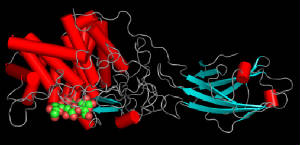|
|
Lactase the Dairy
Enzyme Lactose is a carbohydrate composed of two sugar units (disaccharide). It consists of
a ß-galactose molecule attached by a ß-D-1,4-linkage to a glucose molecule. Lactose or milk sugar is produced
by the mammary glands of many, but not all, mammals. The milk and other dairy products are the primary source of dietary lactose.
Lactose comprises about 4.8-5.2% of milk, 52% of nonfat dry milk solids, and approximately 70% of whey solids. In young mammals, lactase is secreted by the intestinal bile to effectively breakdown dietary lactose. However,
the production of lactase diminishes with age in a large proportion of the population. It is estimated that more than
half of the world's adults suffer from a lactose deficiency and consequently an inability to metabolize dietary lactose (lactose
intolerance). Lactose intolerance symptoms include abdominal bloating, excessive intestinal gas, nausea, diarrhea, and abdominal
cramps. The mechanism for the loss of the enzyme is uncertain. However, it is generally recognized that it is genetically
determined versus the modification of the enzyme protein to a non-catalytic form. Lactose has limited solubility
and crystallization is a problem in ice cream, sweetened condensed milk, and some other dairy products. The resulting lactose
crystals impart an objectionable sharp and gritty mouth feel termed sandiness. LactoDigest Yeast Lactase
is applicable for the production of lactose free and reduced lactose content milk, dairy products, and foods while the
LactoDigest Fungal Lactase is suitable for production of tablets and caplets. Novact Corporation - Biotech Division is a leading manufacturer of Yeast Lactase Enzyme of
50,000 to the Dairy Industy; presentation is in 20 Kg plastic pails (44 lb) and 1 Metric Ton tote (2200 lb) For more information about these enzymes visit the website of Novact Corporation -
Biotech Division http://www.novact.us/ and for specific information on lactase enzymes visit LactoDigest website http://www.lactodigest.com/ |
||||||||||||||||
|
Enzimas - Generalidades |
||||||||||||||||
|
|
||||||||||||||||
|
Novact
Enzymes ENZIMA Provoca el Fraccionamiento de Aspergillus oryzae alfa-amilasa Macromoléculas
de Almidón a fragmentos y azucares (dextrinas, oligosacaridos, D-Glucosa y D-Maltosa) Aspergillus Macromoleculas de Almidón
(carbohidratos) y fragmentos a monosacáridos (D-Glucosa) Aspergillus oryzae lactasa Lactosa (azúcar de la
leche) a monosacáridos o azucares sencillos (D-Glucosa y D-Galactosa) Trichoderma reesei celulasa Celulosa y determinados polisacáridos a pequeños fragmentos (oligosacáridos) Aspergillus oryzae proteasa Macromoléculas de Proteínas a fragmentos más pequeños (polipéptidos
y amino ácidos Aspergillus Macromoléculas de Proteínas
a fragmentos más pequeño (polipéptidos) Rhizopus oryzae lipasa Macromoléculas
de Triglicéridos (grasas y aceites) a fragmentos más pequeños
de ácidos graso, glicerol, mono y diglicéridos) |
||||||||||||||||
|
|
||||||||||||||||


